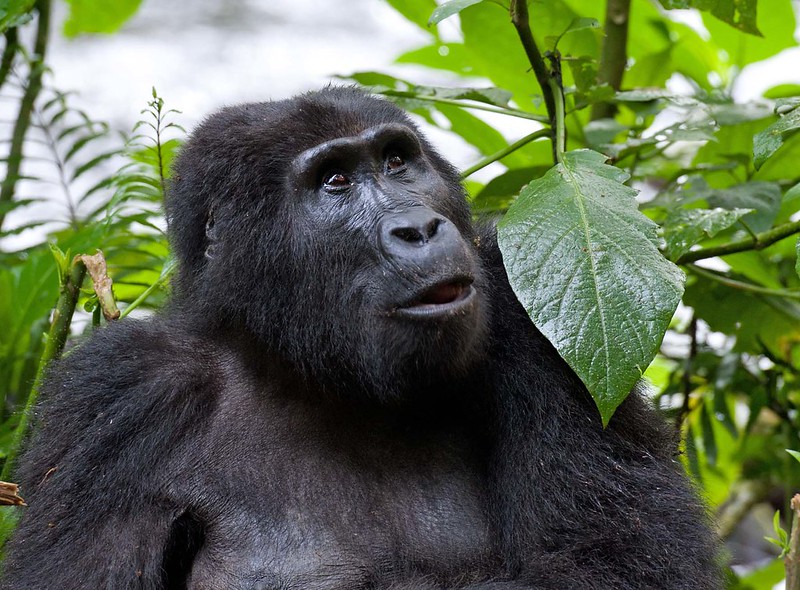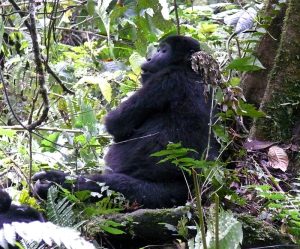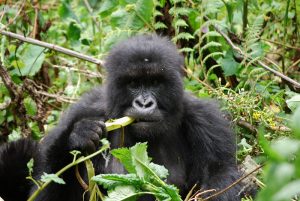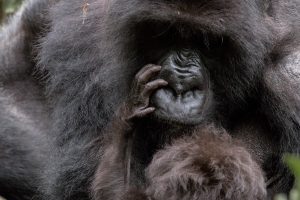A complete Guide to Mountain Gorillas trekking in Uganda
A complete Guide to Mountain Gorillas trekking in Uganda. One of the secret treasures of Uganda are the Mountain gorillas. Within what is known as the Virunga Conservation area which stretches to Uganda, the Democratic Republic of the Congo (DRC) and Rwanda lies these endangered species. In 2018, the International Union for Conservation of Nature (IUCN), categorized mountain gorillas as endangered species. This implied that, mountain gorillas are not conserved in the shortest time possible, they will be on the verge of extinction. The Virunga Conservation region is famous for being home to the subspecies of the Eastern gorilla – the mountain gorilla. They dwell in this area simply because of the abundance of food and shelter. Mountain gorillas live in dense forests and they fancy fruits and tree leaves.
Uganda is home to more than a half of the world population!
Currently, the estimated number of mountain gorillas in this region is approximately 1063 individuals 500 of which are living in Bwindi Impenetrable National Park – little wonder. The park is the most visited by tourists among all the three. The area comprises Bwindi Impenetrable National Park (Uganda), Mgahinga Gorilla National Park (Uganda), Virunga National Park (DRC), and Volcanoes National Park (Rwanda). These national parks have been attracting travelers for both budget gorilla trekking safaris and luxury gorilla trekking tours in their respective countries. Visiting any of the four sectors of Bwindi Impenetrable National Park will give you a chance to trek one of the 20 habituated gorilla families and hence make remarkable memories.
In this complete guide to gorilla trekking safaris in Uganda, you will get all questions concerning gorilla tours answered. The guide is made purposely to give you more insight into the life of these human-like creatures. Whether you believe in the big bang theory or the religious theory, the information herein is yours. We have tried our best to answer most of the Frequently Asked Questions about Mountain gorillas as well as mountain gorilla trekking safaris in Uganda. The information is not only about mountain gorillas in Uganda but rather includes those in Rwanda and DRC. If you are planning a gorilla tour in Uganda soon, this guide is yours to read and keep at the back of your mind.
Which area do I find mountain gorillas in Uganda?
Mountain gorillas in Uganda live in two main areas: the Virunga massif and the Bwindi Impenetrable National Park area. The Virunga massif area comprises Mgahinga Gorilla National Park in Uganda, Virunga National Park in the Democratic Republic of the Congo (DRC), and Volcanoes National Park in Rwanda. Mountain gorillas dwell in areas of high altitude and thick forests like the impenetrable forests of Bwindi National Park. This is because all the conditions available in these areas such as cool temperatures. Ever-green trees, and an abundance of fruits are conducive to the survival of the gorillas.
Are Mountain gorillas the same as human beings?
It would not be right if we said that mountain gorillas are human beings or human beings are mountain gorillas. But they are cousins for lack of a better word. This is simply because mountain gorillas share 98% of the human DNA. This is one of the reasons why many theorists believe that present human beings came from apes of this nature. Their bodies are in the shape of a human being characterized by bigger chests, and shorter hind limbs but taller fore limbs. Their hands are more like those of humans, unlike their bodies which are covered with fur/hair.
More so, mountain gorillas are susceptible to human diseases and illnesses such as flu, Ebola, cholera, and fever, to mention but a few. This is in addition to the 8.5 months gestation periods and living in families. Gorilla families are headed by adult male gorillas known as Silverbacks.
How strong is a mountain gorilla?
When it comes to strength, no other primate on earth is as powerful as a mountain gorilla. An adult male mountain gorilla (silverback) weighs approximately 180 kilograms and their height goes up to about 170 cm. These giant primates eat for long hours a day, they are herbivores that depend on fruits, tree leaves, insects, and roots.
The bigger their sizes, the bigger their shyness. Visiting these gorillas in their habitats during your Uganda gorilla safari will give you an opportunity to watch them play and dine. It on rare occasions to find a mountain gorilla mating in front of humans during the trek but on a lucky day, you may experience their romantic gestures.
Do Mountain gorillas exercise like Human beings?
Mountain gorillas are always on the go. They play while eating especially young ones. They exercise by jumping and walking from one tree to another. Mother Mountain gorillas usually help their babies to stretch while they breastfeed. During your gorilla trekking tour in Uganda, you will see these giant apes as they exercise by suspending themselves on flexible tree branches as though they were in a gym.
How do Mountain gorillas sleep – Do female mountain gorillas sleep with males?
Unlike the chimpanzees that nest in tree branches, mountain gorillas build their nests on the ground and they sleep together. Mountain gorillas, sleep together to get warmth and the young ones usually sleep in their mothers’ chests. The young gorillas depend on their mothers for the first two years until they are strong enough to survive on their own. The family sleeps comfortably under the guard of the adult males known as silverbacks.
How do Mountain gorillas communicate?
Communication in mountain gorillas is not all that developed like one of human beings but compared to other animals, mountain gorillas’ communication is more advanced. Mountain gorillas communicate using gestures and calls. They have more than 10 calls each of which is unique. Usually, mountain gorillas make short barks when they are curious and beat their chests while intimidating rivals. Hooting is a signal of anger or a demonstration of strength and it is common in males when they are showing dominance over others.
During your gorilla trekking safari, do not present any of these and more gestures as you might intimidate their attack. However mountain gorillas are not fond of attacking human beings, they are still animals, and with animals, anything can happen.
How do Mountain gorillas reproduce – do they have sexual intercourse like human beings?
Reproduction in mountain gorillas is more advanced compared to other animals. How do mountain gorillas mate? One might be wondering how these human-like creatures / human cousins mate and reproduce. Female mountain gorillas start ovulating as early as the age of 6 years but sexual maturity is obtained between the age of 10 years and 12 years. This implies that a female mountain gorilla will remain infertile until it is 10 to 12 years old.
Mating in gorillas starts with courtship between a silverback and a female which may last for days. It is always two-way – in other words, the male can initiate or the female can initiate. Sex happens when the two come together and the female gorilla lies down while the silverback mounts on her top as it makes quite a number of ejaculations per mounting. Mountain gorilla females tend to avoid breeding and thus avoid dominant silverbacks and look for new ones. They tend to avoid mating with their fathers to reduce inbreeding. At times mountain gorillas have sex looking at each other’s face something that is not common among other primate species.
In the event that the female is pregnant, she will have a gestation period of 8.5 months. When it is time to give birth, the female gorilla will not eat and stretch quite a number of times. She will take care of her baby for up to 3 or 4 years until it is strong enough to survive on its own. From the time of their birth, young mountain gorillas will be carried by their mothers until the 4th month when they learn to walk. Males do not take much care of young ones meaning that the mother plays the greater role.
Are mountain gorillas social – do mountain gorillas live in groups?
Like human beings, Mountain gorillas live in groups each comprising more than 5 members. Some families can go up to 30 members. Each gorilla family is headed by a male adult known as Silverback. Leadership is not just a question of age but rather strength (the ability to defend the family from rivals), meeting the sexual needs of the female members of the family, searching for food as well and the ability to defeat the current dominant leaders. It is rare to find one family headed by more than one silverback but it has never happened with some families in Bwindi Impenetrable National Park. Female mountain gorillas are fond of associating themselves with silverbacks which meet their responsibilities. This is the reason why some families split and form new families after numbers have increased beyond the normal.
What is the lifespan of Mountain gorillas?
Mountain gorillas can live for up to 40 years while in the wild, they are normally categorized as infants at the age of 3 to 4 years old. And they are classified as an adult at the age of 8 years and above, Male gorillas aged 8 to 12 are considered black backs and from that age, they are called silverbacks since their hair on the back turn to silver.
In the wilderness, mountain gorillas can live up to 40 years while under special care such as a zoo, they can reach 50 years. They are considered young from 0 to 4 years and they are considered to be adults from their 8th birth day on wards. Black backs are male gorillas between the age of 8 years and 12 years. At the age of 12 years and above, male gorillas are referred to as silverbacks as they grow silver hair on their back.
Are mountain gorillas an endangered species?
After realizing that mountain gorillas are at the verge of extinction, in 2018 the International Union for Conservation of Nature (IUCN) categorized mountain gorillas as endangered species. This was because of human activities that threaten the habitats of these beautiful apes. These activities included bush burning, deforestation and poaching. This resulted into the reduction in numbers of mountain gorillas and they those that remained went deeper in the forests. The good news is that efforts from the government and other stakeholders have been made to ensure that mountain gorillas survive extinction. In pursuit of this goal tremendous success has been achieved and the region has the highest number of mountain gorillas in the world.
Is gorilla trekking worth the money – is gorilla trekking in Uganda worth it?
Quite a number of people wish to know why gorilla trekking in Uganda is expensive compared to other African safaris. The answer is simple – gorillas are the biggest primates and the most attractive of all. They can only be found in Africa that is Uganda, Rwanda and Democratic Republic of the Congo (DRC). When you talk of mountain gorillas what should come to your mind is Bwindi Impenetrable national park, Mgahinga Gorilla national park, Volcanoes national park and Virunga national park.
Hundreds of travelers from different parts of the world visit Bwindi Impenetrable national park every year in search of this amazing gorilla experience. There is a reason behind every price! There is a lot that is invested in conservation of these species hence without money, the gorillas would find it hard to thrive in this region. A balance between the human needs and the needs of the gorillas has to be there. This is why gorilla trekking has quite a number of rules and regulations governing it. Doing a mountain gorilla trekking safari in any of these national parks will give you an insight on why the activity looks to be expensive.
The giveback to the community programs can also be the reason for the expensiveness of gorilla trekking tours in Uganda. This is called sustainable tourism – the only tourism driving towards growth and development while conserving nature. This program is designed to give back to the members of the communities living within these areas. It is an appreciation for them having harmoniously co-existed with the mountain gorillas. You should therefore know that whenever you buy a gorilla trekking permit in Uganda, you are giving back to the communities around the parks.
More than the gorillas
Additionally, gorilla trekking experience is worth it in a way that it comes with a lot of additional experience which include but not limited to spectacular walk in the green forests, views of other animal species, as well as bird and plant species. Trekking mountain gorillas in Uganda can never leave you the same. Within the forests, you will be given a full hour to spend in the presence of the mountain gorillas upon encountering them. This give you an opportunity of getting all your curiosity satisfied. You will enjoy them as they play, jump and dine. You will be awarded with a gorilla trekking certificate in the event of finishing the trekking successfully.
Other than mountain gorillas which dwell in the highlands, there is yet another group of sub-species known as the lowland gorillas. These gorillas can only be located in the forests of Democratic Republic of the Congo (DRC) in the areas of Kahuzi and Biega. Kahuzi Biega national park offers a great gorilla experience that can easily be combined with a Rwanda gorilla safari or a Uganda gorilla safari.
How long does gorilla trekking take?
Gorilla trekking in Uganda starts at 8:00 am with a briefing at the park headquarters. It is here that you are told about the dos and don’ts of the gorilla trekking activity. After the briefing, you will be grouped into groups of eight members. Grouping depends on first come first served as well ability for example the sick, the elderly are given a gorilla family that can be easily trekked. Each group is entitled to trek one gorilla family a day. Trekking begins there and then. You will walk the trails under the leadership of an experienced guide.
Meeting the gorillas depends on how fast your group moves and where the gorillas spent the previous night. The entire activity takes 1 to 8 hours including the one hour that you are given to spend in the presence of the gorillas upon encountering them. It is therefore wise to give this activity a full day while planning your safari since gorillas can take long to be spotted in the shortest time possible especially in low seasons.
How much is a gorilla trekking permit in Uganda?
Gorilla trekking permit fees differ depending on the country visited, with Rwanda being the most expensive gorilla trekking destination while D.R. Congo is the cheapest. Uganda which has half of the population of mountain gorillas gorilla permits go for USD 700, USD 600 and UGX 250,000 for foreign nonresidents, foreign residents and east African citizens respectively. In Rwanda, a gorilla trekking permit goes for USD 1500 making it the most expensive gorilla destination and D.R. Congo gorilla permits go for USD 400 for foreigners and USD 200 for foreign nationals.
What is the best time to go for gorilla trekking in Uganda, Rwanda and DRC?
Uganda, Rwanda and DRC (the Virunga massif) are open destinations all year round unless otherwise. This implies that, gorilla trekking is an activity that can be done throughout the year. While some travelers enjoy trekking during the rainy seasons, others love dry seasons.
However, the rainy seasons are good for trekkers who are physically fit and can thrive the slippery trekking trails. In the rainy seasons, gorillas tend not to move since they have abundant food and in the dry season, gorillas move a lot to distant areas as they search for food. The trails are always muddy compared to the dry season. The forests tend to be thicker during the wet seasons which is why the dry season is always the best time for gorilla trekking in Uganda, Rwanda and DRC. Each year has two rainy and dry seasons – that is from March to May and from October to November, as well July – October and December to February respectively.
Can I take a flight to trek gorillas in Uganda?
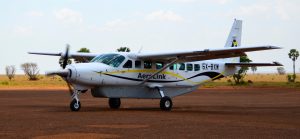
More than 60% of the travelers that come to Uganda majorly come for gorilla trekking safaris. Just yearning to have one of those lifetime encounters with the mighty apes of the forest? Watching little juveniles play from one tree branch to the other is simply an experience for life. Unfortunately, the most hindering challenge that has always been demotivating Ugandan tourists is the long driving hours to Bwindi impenetrable national park. The nine hour journey, almost a full day of just transferring to the park. Sitting in the vehicle is something that most travelers find to be so difficult.
Perhaps this is the very reason why most travelers to Uganda’s Bwindi national park have been currently going to the park through Kigali, because it is much closer and easier to connect to from Rwanda than from Uganda’s capital Kampala.
However, this is no more a challenge, for travelers who are scared of the long nine hours transfer journey to the park, here we present to you flying safaris to Bwindi impenetrable forest national park to make your Uganda safari short and easy.
Fly to Bwindi and Mgahinga national parks
Currently, Aero Link, Eagle Air and Fly Uganda offer domestic flight services, and so far no failures have been registered. Flights are scheduled on different days and hours, however even the chartered services can be provided. There are direct flights from Kajansi airstrip to different national parks and other tourism destinations around the country. These are meant to ensure that tourists reach their desired spots in a quicker and easier way. Uganda flying safaris give travelers with limited time a chance to explore the pearl of Africa in a very short time.
Now with domestic flights to Bwindi impenetrable national park, trekkers are saved from the nine hours journey. Flying from Kajansi to Kihihi airstrip takes one hour. From Kihihi, travelers are transferred by vehicle to the respective region of trekking.
The fact that flying to Bwindi national parks nearly takes one hour, it is very easy for trekkers to have the gorilla experience in just two days using the scheduled flights, and if it’s a chartered flight, one can even see the gorillas and return to Kampala on the very same day.
Note that these domestic flight servers also offer flights to other national parks other than Bwindi impenetrable national park. They also go to Murchison falls national park, Kidepo valley national park, Mgahinga national park and Queen Elizabeth national park. All these making your safari in Uganda exceedingly awesome and in a very short time.
Besides the mountain gorillas, a tour in Uganda exposes you to several other different attractions that have not only overwhelmed the visitors, but also left them yearning for more and more safaris in the pearl of Africa.
What is the difference between Gorilla trekking and Gorilla habituation experiences?
While both activities take place in similar destinations, gorilla trekking and gorilla habituation are not the same. The difference is that, for gorilla trekking, travelers come to see mountain gorillas which are already used to human beings (habituated). On the other hand, gorilla habituation involves visitors visiting gorilla families which are not all that used to human beings. In other words, such families must be habituated quite a number of times so that they can qualify to be trekked. Once a gorilla family is fully habituated, it is given a name and it is declared as one open for trekking.
The other difference comes when it comes to the number of people allowed to partake a given activity. For instance only 8 people are allowed to trek a given gorilla family whereas only 4 people can do gorilla habituation. This is done so that gorillas can gradually get used to human beings.
Additionally, gorilla trekking permits in Uganda go for USD700 , USD600 and UGX250,000 for foreign non-residents, foreign residents and members of the East African Community respectively. On the other hand, gorilla habituation permits in Uganda go for USD1,500, USD1,000, and UGX 750,000 for foreign non-residents, foreign residents and members of the East African Community respectively.
Tips for gorilla trekking in Uganda
Gorilla trekking involves a physical walk or a hike through the rugged trials in the gorilla destinations. The pathways are usually slippery especially in the rainy seasons, coupled with a number of small water streams and thick vegetation crossing over and penetrating respectively.
Health tip for gorilla trekking in Uganda
It is important to have a certain level of physical fitness for gorilla trekking. Trekkers are exposed to various infections such as Flu, coronavirus, malaria, a running stomach or any kind of disease that might be a threat to endangered apes. The category of these people may not be allowed to trek the mountain gorillas.
However, there is a great possibility for disabled gorilla trekkers. If they are in good health conditions, with the help of porters and carriers. This vulnerable group is able to experience gorilla life in the jungle.
With the required documentation such as valid gorilla permits and negative Covid-19 test results, all are in check. An appropriate gorilla trek attire would be the last on the check box to begin your jungle trek of the gorillas.
What to wear on a gorilla trekking safari in Uganda
With the ever-changing weather conditions of the tropical forest, where the gorillas are found. It is necessary for gorilla trekkers to prepare for all weather changes while in the forest. Whether it rains, or in the scorching sun, the trekking experience should be enhanced and made easy.
Gorilla trekking is East Africa is a unique activity that has been of great interest to many primate lovers all over the world. When choosing what to wear for gorilla trekking, many factors come into play like weather, terrain and health. It is important to know the appropriate wear, suitable for gorilla trekking in Uganda, Congo and Rwanda.
The comfort and flexibility of the trekking gear when trekking the gorillas make the gorilla experience a lot more memorable and fun. As the gorillas are reached with much ease.
What to wear for gorilla trekking is very important. However, there are also items to bring along after wearing the appropriate gear. Below are a few;
-
Face masks and sanitizers.
Due to the global pandemic, it is almost impossible to access any destinations without wearing a protective face mask. Additionally, frequent use of hand sanitizer is also deemed important. This applies while trekking the mountain gorillas in the jungle.
Mountain gorillas are contagious to infectious viruses. This makes it important to trek the mountain gorillas while healthy, never the less wearing face masks for the Post COVID-19 travelers. This promotes the conservation of these wild species by protecting them from the contraction of various infectious diseases.
-
Hiking gloves to wear
The trek through the jungle may be seen as a “bump walk”. The rugged and slippery terrain of the forest require a strong grip to keep balance when trekking. Small fitting gloves help to grasp tree branches as support while trekking the uneven terrains of the forests. These as well help to protect the hands and fingers of a trekker from sharp plant hook piecing. Some vegetation in the forest carry horns, itching, and rough surfaces.
-
Hiking boots to wear
The impenetrable forest is host to a number of unfamiliar species and plants that could hinder a gorilla hiking experience if not well dressed. Comfortable hiking boots help to step onto any rugged ground of the forest. Without worrying about losing balance or stepping onto sharp piercing objects. The boots surface well with the muddy, sticky ground of the forest which makes gorilla trekking faster and easier. Comfortable and well-fitting boosts are recommended when choosing gear for your gorilla safari.
-
Waterproof jacket to wear
Since the gorilla destinations are mostly found in tropical forests, especially the Bwindi forest. This guarantees higher chances of rain pour even during the trekking sessions. To safeguard and keep warm even with the tropical rain in the forest, a waterproof jacket would be of great help while trekking the mountain gorillas.
-
Hiking trousers
The thorny vegetation, creeping insects, and buds will, unfortunately, make gorilla trekking not a comfortable experience when wearing light trousers and shirts. Long hiking trousers made of light, and “breathable” material will surely make all trekkers comfortable. And protected from skin stretches, and insects bites while trekking the mountain gorillas.
-
Insect repellent to bring for gorilla trekking
The gorilla jungle is full of micro insects that are different on the floor and vegetation of the gorilla habitats. A little spy of an insect repellent will help keep insects and buds from crawling onto a trekker’s body.
Do disabled people and the elderly do gorilla trekking in Uganda? – Gorilla trekking for people with disabilities in Uganda.
Specifically, persons with disabilities usually find gorilla trekking so challenging or even impossible to be done. But with the increasing concerns and requests from these people. This has become history with the initiative of aiding the disabled and elderly enjoy a gorilla trekking safari in these countries.
A team of 12 energetic indigenous porters (who are familiar with the relief of this area) is assigned to carry a person on either the traditional bamboo carrier or the sophisticated sedan chair. However, this depends on availability at the time of booking.
Are you disabled and you are worried about gorilla trekking in Uganda? Don’t worry anymore. There is an opportunity of trekking these endangered great apes on sedan chairs.
Movement options
The transport aids make ferrying the client easier up the mountain ranges and through the jungles. They have handles all round them which make it easier for handling the stretcher by the porters. A team of well bodied porters. They are natives and have the best knowledge of the terrain of the area carry the individual. The carrier service comes at an extra cost of the $350 to $500. Depending on the weight of person to be carried. If you wish to be included for a special need safari, you will need to book a trekking permit in advance.
Where to stay?
There are a number of lodges ranging from luxury / high end, midrange and budget that have options for people with disabilities and special facilities for wheel chair access.
Quick questions with quick answers concerning gorilla trekking in Uganda
How difficult is the gorilla trek in Uganda?
Not so difficult but requires a certain degree of physical fitness especially during the rainy seasons
How many days do you need to go gorilla trekking?
One day is enough but doing more than that has no problem
Is Uganda or Rwanda better for gorilla trekking?
Uganda has more advanced trails compared to Rwanda. Uganda has two national parks offering this activity unlike Rwanda which has one. But all the experiences are spectacular.
How much do you tip a gorilla trek?
There is no set price for tipping but 10 USD are good for the day
How much does it cost to trek with gorillas?
Uganda gorilla permits go for USD700, USD600 and UGX250,000 for foreign nonresidents, foreign residents and east African citizens respectively. In Rwanda, a gorilla trekking permit goes for USD 1500. This makes it the most expensive gorilla destination. D.R. Congo gorilla permits go for USD 400 for foreigners and USD 200 for foreign nationals.
Where can I track gorillas in Uganda?
Bwindi Impenetrable national park and Mgahinga Gorilla national park
When is the best time to go for gorilla trekking in Uganda?
The dry months of July to October and December to February respectively.
When is the best time to secure a gorilla permit in Uganda?
Best 3 or 6 months before arrival through your tour agent in Uganda
What are the rules and regulations around gorilla trekking in Uganda?
BEFORE YOU SET OUT
- Ensure to carry with you payment receipts and permits
- Do not visit the gorillas if you have a cold or other infectious illness
- Minimum age for tracking is 15 years
- Human waste should be buried 30 cm (12) deep
- Maximum number of visitors is eight persons per gorilla group
WHEN YOU ARE WITH THE GORILLAS
- Maintain a 7m (21ft) distance from the gorilla
- Smoking, eating and drinking are not permitted on the tour
- If you must sneeze or cough cover your face and turn away from the gorillas. They can catch coughs and colds from humans
- Visits are limited to one hour per gorilla group per day
- Do not use flash photography
Are gorilla sightings guaranteed in Uganda?
Since they are wild animals we guarantee 90% chances depending on the season as well.
Do Mountain gorillas eat human beings?
No, they can only charge once provoked but on rare occasions
In conclusion therefore, the best travel experience comes to those who read about their destinations in advance. Thank God, you are one of them now that you are up to this point. Enjoy your journey as you explore the gorillas of the Pearl. Book a Uganda Mountain gorillas trekking Safari Now.

